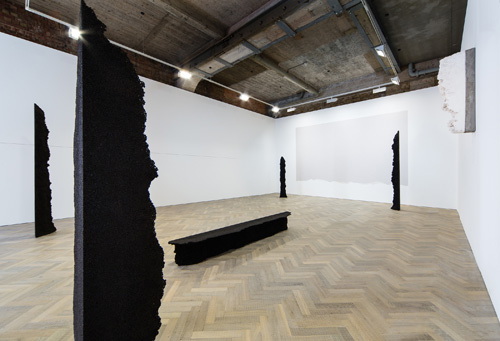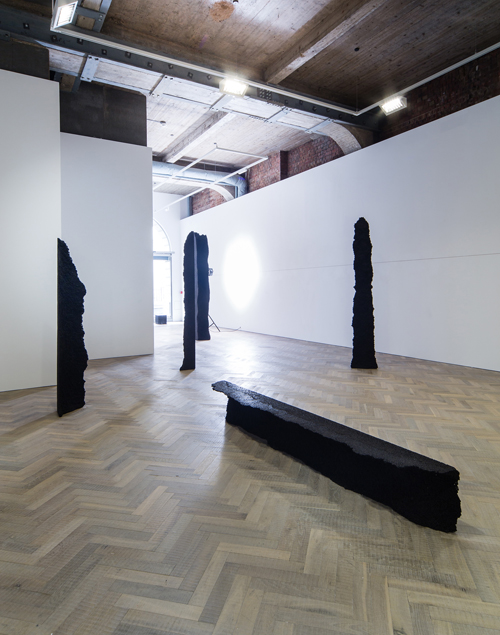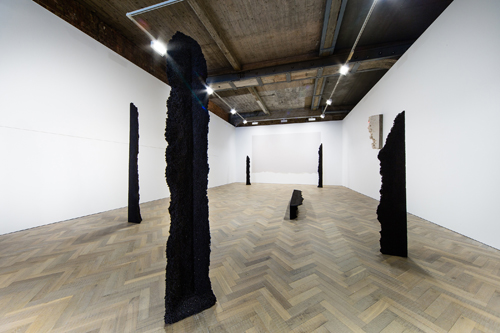

Thomas Dane Gallery, London
17 April – 23 May 2015
by HARRY THORNE
The fact that I deny using Wikipedia to plan my reviews does not mean I don’t use it. But I must defend myself. It is not in search of facts that I am drawn to “the free encyclopaedia”. Instead, I use it to gauge exactly what kind of artist I am working with. Ordinarily, there are two camps. The first are those with extended biographies, rich in colour and detail but lacking any concrete evidence of prior exhibitions. The second, and those I tend to prefer, feature smaller and more impersonal background paragraphs that are dwarfed by the vast list of previous shows that sits below. Michel François, I am happy to say, is fully entrenched in this second camp.
“Michel François (born 1956, Saint-Trond, Belgium)”, the Wikipedia entry reads, “is a Belgian artist. He lives and works in Brussels, Belgium. His art explores a variety of media including installation, video, sculpture and photography.” There, with no considerable explanation provided beyond the fact that, yes, he is Belgian, it ends. But while the description concludes, the page does not, for beneath is a list of bullet points outlining the 83 solo shows and 177 group exhibitions that François has featured in over the past 27 years, having made visits to the Venice Biennale, the Centre Georges Pompidou and SMAK Ghent along the way. The reason for my interest in the Wikipedia entries for artists such as François is that, while they may be established, their work is still able to evade over-definition. They are not artists who can necessarily be condensed, enclosed and restricted within cheap paragraphs of specific dates and exterior references, but they continue to experiment and question, and in doing so resist definitive categorisation. Simply put, they are still exciting.
A Frozen Eagle Melting on the Theatre of Operations, François’ latest exhibition at Thomas Dane Gallery, London, is demonstrative of this. Seven large stalagmites rise from the floor of the space, each named Untitled (2015) and each formed of jet-black asphalt, a material that is as unconventional as it is unsurprising when the artist’s previous use of ice, rubber, soap and sponge is taken into consideration. While at first glance these objects appear strong and fully formed, their dark silhouettes reaching proudly above those observing below, on closer inspection they cut much less confident shapes. Each sculpture stands half completed, with one or two sides perfectly finished, and the others crumbling away. It is a fragmentation that conjures images of dilapidated ruins or scorched houses, and it works in their favour, because while large, polished sculptures can often be jarring and unnaturally commanding in a habitat that is ultimately not their own, these Untitled works are unthreatening. They slip seamlessly into the space as if they have been there for decades, creating a peculiar ambience of mystique and familiarity.
Moving away from the visual qualities of these works, however, François’ obelisks also raise interesting questions of definition. I previously used the phrase “half completed” to describe the premature states of these works, but this may have been a poor choice of words. For while each Untitled sculpture appears to be several steps from its completed, adult form, it is actually uncertain as to whether they are the products of incompletion or decrepitude. Are they partly formed, or are they fallen? This ambiguity is further exacerbated when we consider the simple fact that, while we perceive these bodies to be fragments, they are, of course, finished works. So here we come to ask: are they fragments after all, are they completed articles, or are they both?
François’ interest in these areas of juxtaposition and ambiguity is also present in the several works surrounding this series: To Snatch (Wallpaper) (2013), a section of beige wallpaper pasted on to the far wall of the gallery and torn along the underside, Froissé (Dans le Plâtre) (2014) – roughly translated as Crumpled (In the Plaster) – a white plane ripped in several sections to reveal a panel of dented black aluminium underneath, and most noticeably Disappearance of a Ligne (2015).
In his 2014 exhibition Pieces of Evidence, at Birmingham’s Ikon Gallery, François cut a hole in the upper wall of the main space to assess the boundaries of his art. It is a method he has mimicked for Disappearance, a thin horizontal line cut along the sidewall of Thomas Dane, a shallow groove, but one significant enough to be physically present. At one end of the work, however, the line disappears beneath the glare of a powerful spotlight. I say disappears, but it is impossible to know whether or not the line is there, because every time you try to follow its trajectory, you meet with the spotlight and your eyes lose all capacity to adjust. The groove is lost in a blind spot, simultaneously present and not. Like the adjacent asphalt totems, here again is a simple work – an optical illusion – that in its apparent incompletion draws our attention towards what is absent and coerces us into taking over the responsibility of questioning.
A Frozen Eagle is something of a reification of François’ Wikipedia page, for while the artist’s prowess is evident, almost no supplementary analysis of the work is available. We circle the Untitled totems, repeatedly scrambling to gather any facts or reference points that could place us back in a position of control, but on each occasion we inevitably find ourselves empty-handed, tasked to complete a puzzle with none of the relevant pieces at our disposal. It is this calculated retention of information that makes this exhibition so absorbing. François continually teases at our innate human drive to understand and to solve problems in order to force us into the work itself. Yes, more information could be provided, the Wikipedia page could be more thorough, but if that were the case then both our questioning and our conscious involvement would all but cease. Why would be bother thinking about the asphalt blocks if we knew what they were? Why would we stop to look at the point where the line disappears? Why would we even turn up? After all, we could just read about it online.


